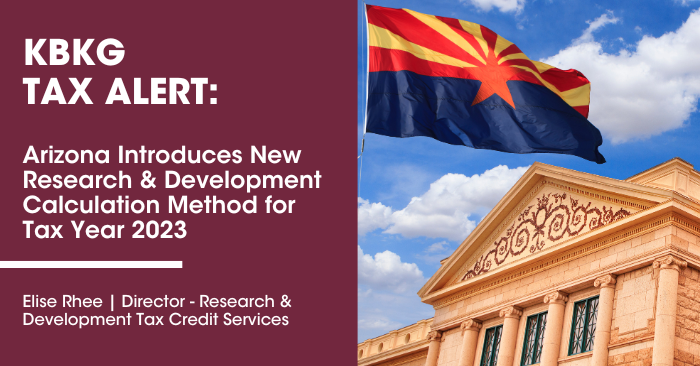KBKG Tax Alert: Arizona Introduces New Research & Development Calculation Method for Tax Year 2023
By Elise Rhee| Director, Research & Development Tax Credits
Effective for the tax year ended 2023, Arizona has implemented a new calculation method, mirroring the federal Alternative Simplified Calculation (ASC) approach. Notably, if a taxpayer hasn’t incurred qualified research expenses (QREs) in any of the preceding three taxable years, they are ineligible for the ASC.
Refundable Portion of the Current Year’s Excess Credit
To qualify for this refund:
- The taxpayer must employ fewer than 150 full-time employees.
- Application to the ACA for a Certificate of Qualification (Certificate) is mandatory for refund eligibility.
- The refundable amount is determined as the lesser of:
- Seventy-five percent of the excess credit.
- The maximum refund amount specified on the Certificate, with any additional amount forfeited.
How Refunds Are Calculated
- The excess credit refers to the current year’s credit minus the current year’s tax liability. It’s crucial to note that the 75% refund pertains exclusively to the current year’s excess credit for increased research activities.
- Arizona Form 3082
- The decision to make this credit refundable must be declared when originally filing the tax return to claim the current year’s credit.
What is the R&D Tax Credit?
The Research and Development Tax Credit is a reduction in federal tax liability that companies can take for approved domestic expenses. This is a dollar-for-dollar rate of reduction. You also get back approximately 13 cents for every dollar spent on research that meets the eligibility requirements. Qualifying research and development expenses include the development, improvement, or design of a product, technique, process, or software.
This credit can lead to significant savings that free up cash for further R&D, hiring new employees, and more. For companies that meet the criteria of a Qualified Small Business, the R&D credit can be used to offset quarterly payroll taxes. For tax years 2016 through 2022, the maximum R&D tax credit for payroll tax was $250,000. The credit doubled to $500,000 beginning January 1, 2023. Many states have also enacted an R&D credit.
What are the State Benefits?
Aside from the federal R&D tax credit, certain states also offer their own R&D credit for product, process, or software development. While many states align closely with federal rules, some require separate applications and impose industry-specific restrictions or caps on annual credits.
State-level credits can also surpass federal credits, as they may offer higher rates, allow credits to transfer, or even provide cash value regardless of tax liability. Understanding these nuances is crucial to navigating R&D tax credits and ensures taxpayers capture the maximum amount of benefits offered by individual states.
Elise Rhee | Director – Research & Development Tax Credits
Elise Rhee is a Director with KBKG working for the Research and Development (R&D) Tax Credit department. She has 8 years of consulting experience providing R&D tax credit services to companies ranging from architectural & engineering, food & beverage, software development, cosmetics, manufacturing, automotive, and aerospace & defense. Read More



